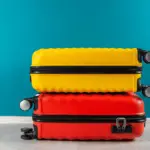Airlines keep raising baggage fees while shrinking overhead compartment space, forcing travelers to master the art of carry-on-only travel. A revolutionary packing technique spreading across social media platforms is transforming how people approach luggage, allowing entire wardrobes to fit into standard carry-on bags through strategic folding and compression methods.

This packing revolution emerged from necessity as checked baggage fees now cost travelers between 30 and 100 dollars per flight, depending on airline and destination. Frequent travelers began sharing techniques that maximize every cubic inch of carry-on space, creating a movement that challenges traditional packing wisdom and proves that strategic organization trumps larger luggage.
The transformation from traditional packing to modern compression techniques represents more than just space savings. Travelers report reduced stress, faster airport navigation, and elimination of lost luggage concerns. The method requires specific tools and techniques, but mastering these approaches can revolutionize travel experiences for anyone willing to learn the system.
The Magic of Compression
Understanding why compression packing works requires examining how air affects luggage volume. Traditional folding methods trap significant air between fabric layers, creating bulk that wastes precious carry-on space. Modern compression techniques eliminate this trapped air through mechanical and strategic approaches.
Compression cubes take space optimization to the next level with an extra zipper around the outside that minimizes the space inside the cube when you close it. This double-zipper system creates vacuum-like effects that can reduce clothing volume by significant percentages, transforming bulky items into compact packages.
The physics of fabric compression reveals why this method succeeds where traditional folding fails. Natural and synthetic fabrics contain varying amounts of air within their fibers and between layers. Compression systems squeeze out this excess air while maintaining fabric integrity, creating dramatic space reductions without damaging clothing.
Temperature and humidity affect compression results, with dry, cool conditions providing optimal compression ratios. Travelers packing in humid environments may find slightly reduced compression effectiveness, while those packing in dry conditions can achieve maximum space savings through proper technique application.
Strategic Folding Versus Rolling Methods
The debate between folding and rolling clothing has dominated packing discussions for years, but recent innovations suggest that strategic combinations of both methods deliver superior results. Different clothing types respond better to specific treatment methods, requiring tailored approaches for optimal space utilization.
Structured garments like dress shirts and blazers benefit from precise folding that maintains shape while minimizing wrinkles. The key involves folding items to exact dimensions that match packing cube interiors, eliminating wasted space along cube edges and corners.
Rolling works exceptionally well for casual clothing, undergarments, and flexible fabrics that don’t wrinkle easily. The rolling technique compresses fabric layers while creating cylindrical shapes that pack efficiently into available spaces. However, rolling alone doesn’t achieve maximum compression without additional compression tools.
Hybrid approaches combine both techniques strategically. Travelers might roll t-shirts and casual wear while folding dress clothes and structured garments. This mixed methodology allows customized treatment for different clothing types while maximizing overall space efficiency.
The most effective approach involves measuring packing cube dimensions precisely and folding or rolling items to exact specifications. This mathematical precision eliminates dead space within cubes and ensures every millimeter serves a purpose in the overall packing strategy.
Equipment Selection and Quality Considerations
Success with advanced packing techniques depends heavily on equipment quality and selection. Not all packing cubes provide equal compression capabilities, and choosing the right tools makes the difference between success and frustration.
Prioritize cubes with strong zippers and compression features that deliver up to 60% space savings. The most effective compression cubes feature robust construction with heavy-duty zippers that withstand repeated compression cycles without failure.
Size variety becomes crucial for maximizing space efficiency. Complete packing cube systems include multiple sizes that work together like puzzle pieces, filling every available inch of carry-on space. Standard sets typically include small cubes for undergarments, medium cubes for shirts and lightweight items, and large cubes for bulky clothing.
Premium options feature sturdy stitching, premium YKK zippers, and an ability to repel liquid, which protects contents from accidental spills and comes in handy for separating damp clothing. These additional features justify higher costs for frequent travelers who demand reliability and versatility.
Water resistance provides unexpected benefits beyond spill protection. Compression cubes with water-resistant exteriors maintain their shape better during compression and offer improved durability over extended use periods. The investment in quality equipment pays dividends through years of reliable service.
The Tetris Strategy for Maximum Efficiency
Successful carry-on packing resembles a three-dimensional puzzle game where every piece must fit perfectly to achieve maximum efficiency. This approach requires strategic thinking about item shapes, sizes, and compression characteristics before beginning the packing process.
The most effective packers visualize their carry-on interior as a grid system with designated zones for different item categories. Shoes occupy specific corners, toiletries fit into predetermined spaces, and clothing cubes fill remaining areas according to predetermined arrangements.
Layering strategies maximize vertical space utilization within carry-on bags. Dense, heavy items form the foundation layer, while progressively lighter items stack above. This arrangement prevents crushing of delicate items while maintaining bag balance and accessibility.
Sequential packing order becomes critical for efficiency. Experienced travelers pack items in reverse order of anticipated need, placing items needed first in easily accessible locations while burying items needed later in trip deeper within the bag structure.
The most advanced practitioners develop personalized packing templates that remain consistent across multiple trips. These templates speed packing processes while ensuring nothing gets forgotten and every item has a designated location within the carry-on system.
Climate Adaptation and Wardrobe Strategy
Packing for multiple climates within carry-on constraints requires strategic wardrobe selection that prioritizes versatility over variety. The key involves choosing items that serve multiple purposes while maintaining appropriate style for different occasions and weather conditions.
Layering systems prove most effective for climate variability. Base layers, insulating layers, and outer shells can combine in multiple configurations to address different temperature ranges without requiring separate outfits for each climate condition.
Fabric selection dramatically impacts both versatility and packing efficiency. Merino wool provides excellent temperature regulation, wrinkle resistance, and odor control while maintaining compact packing characteristics. Synthetic performance fabrics offer similar benefits with added durability and faster drying times.
Color coordination simplifies wardrobe planning while reducing total item count. Neutral color palettes allow multiple mix-and-match combinations from fewer individual pieces, creating varied outfit options without requiring extensive wardrobe selections.
Footwear represents the greatest challenge in multi-climate packing. The solution involves selecting one or two pairs that work across different environments, potentially supplemented by lightweight options that pack efficiently for specific activities or climates.
Organization Systems That Work
Effective organization systems extend beyond simple compartmentalization to create intuitive systems that speed both packing and unpacking processes. The most successful systems consider both storage efficiency and retrieval convenience.
Category-based organization proves most effective for most travelers. Grouping similar items together creates predictable storage patterns that become automatic over time. Undergarments occupy specific cubes, outerwear groups together, and accessories maintain designated spaces.
Frequency-based organization prioritizes item accessibility based on anticipated usage patterns. Items needed daily or multiple times per day receive premium placement in easily accessible locations, while items needed occasionally can occupy less convenient storage areas.
Visual identification systems speed item location during travel. Clear or mesh panels on packing cubes allow contents identification without opening multiple containers. Color-coding systems can further enhance organization efficiency for travelers who prefer systematic approaches.
Inventory management becomes crucial for longer trips or complex itineraries. Simple lists help track item locations and ensure nothing gets forgotten in hotel rooms or inadvertently left behind during hurried departures.
Professional Travel Applications
Business travelers face unique packing challenges that require specialized approaches to carry-on optimization. Professional wardrobes typically include more structured garments that resist traditional compression methods while demanding wrinkle-free presentation upon arrival.
Garment folders provide solutions for business attire that must maintain professional appearance. These specialized packing tools fold dress shirts, suits, and dresses in specific patterns that minimize wrinkles while achieving reasonable compression ratios.
Technology integration adds complexity to business travel packing. Laptops, tablets, chargers, and accessories require dedicated space allocation that competes with clothing storage. Strategic planning balances technology needs with wardrobe requirements.
Time constraints affect business travel packing strategies. Frequent business travelers develop streamlined systems that enable rapid packing and unpacking cycles, often maintaining partially packed bags that remain ready for spontaneous travel requirements.
Security considerations influence business travel packing decisions. Valuable items require secure storage within carry-on bags while maintaining reasonable accessibility for security screening and potential inspection procedures.
Long-Term Travel Adaptations
Extended travel periods require different strategies than short trips, with emphasis shifting from maximum compression to sustainable organization systems that support longer-term living from carry-on bags.
Laundry planning becomes critical for extended carry-on travel. Strategic clothing selection emphasizes quick-drying fabrics and items that maintain appearance through multiple wash cycles. Packing includes basic laundry supplies and planning for regular washing opportunities.
Seasonal transitions during extended travel create unique challenges. Travelers might begin trips in winter conditions and move to tropical climates, requiring adaptive strategies that accommodate dramatic climate changes without exceeding carry-on limits.
Souvenir and acquisition planning affects long-term carry-on strategies. Extended travelers must plan for items acquired during travel while maintaining carry-on compliance. Some travelers ship items home periodically to maintain packing flexibility.
Living routines adapt to carry-on constraints during extended travel. Daily organization systems must function efficiently in various accommodation types while supporting both packing and unpacking cycles that might occur frequently.
Innovation Trends
Emerging technologies continue advancing carry-on packing efficiency through improved materials and innovative design approaches. Smart fabrics that resist wrinkles and odors while maintaining compact packing properties represent significant advances over traditional materials.
Advanced compression systems now achieve space savings that allow multiple cubes to fit efficiently in standard carry-on configurations while maintaining full depth utilization. These improvements enable more sophisticated packing strategies with better organization capabilities.
Digital planning tools help travelers optimize packing strategies through virtual packing simulations and item tracking systems. Apps that calculate weight and volume distributions prevent overpacking while ensuring essential items receive priority placement.
Material science advances produce lighter, stronger packing accessories that provide better compression ratios while lasting longer under frequent use conditions. These improvements justify higher initial investments through improved performance and durability.
Integration between packing systems and luggage design creates more efficient overall solutions. Some manufacturers now design carry-on bags specifically optimized for compression cube systems, maximizing compatibility and space utilization.
The revolution in carry-on packing represents more than simple space optimization. These techniques enable travel freedom through reduced costs, increased mobility, and elimination of luggage-related stress. Mastering these methods requires initial investment in proper equipment and time spent learning techniques, but the rewards include transformed travel experiences that prioritize adventure over luggage management.
Modern travelers increasingly recognize that strategic packing enables spontaneous travel opportunities while reducing overall travel costs and complications. The skills required for expert carry-on packing transfer to other areas of travel planning, creating more confident, capable travelers who approach adventures with reduced anxiety and increased flexibility.




